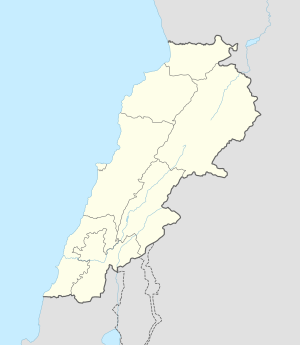Aadloun
عدلون | |
|---|---|
town | |
 | |
| Coordinates: 33°24′14″N 35°16′26″E / 33.40389°N 35.27389°E | |
| Country | |
| Governorate | South Governorate |
| District | Sidon District |
| Elevation | 300 ft (100 m) |
| Time zone | UTC+2 (EET) |
| • Summer (DST) | UTC+3 (EEST) |
 | |
| Alternative name | Abri Zumoffen (Aadloun I), Bezez Cave, Mugharet el Bzaz (Aadloun II) |
|---|---|
| History | |
| Periods | Early Yarbrudian (Acheulio-Yarbrudian), Levalloiso-Mousterian, Upper Paleolithic, Heavy Neolithic |
| Cultures | Paleolithic, Neolithic, Phoenician |
| Site notes | |
| Excavation dates | 1898, 1900, 1908, 1958, 1963 |
| Archaeologists | Godefroy Zumoffen, Dorothy Garrod, Diana Kirkbride |
| Condition | Ruins |
| Management | Directorate General of Antiquities |
| Public access | No |
Aadloun, Adloun or Adlun (Arabic: عدلون) is a coastal town in South Lebanon, 17 kilometres (11 mi) south of Sidon famous for its cultivation of watermelons. It is also the site of a Phoenician necropolis and prehistoric caves where four archaeological sites have been discovered and dated to the Stone Age.[2] The evidence of human occupation of Abri Zumoffen (or Aadloun I) has been dated as far back as 71,000 BCE with occupation of Bezez Cave (Aadloun II) dating back even further into the earlier Middle Paleolithic.[3]
- ^ Aadloun, localiban
- ^ Copeland, Lorraine; P. Wescombe (1965). Inventory of Stone-Age sites in Lebanon, pp. 63-64. Imprimerie Catholique. Retrieved 21 July 2011.[permanent dead link]
- ^ Copeland, Lorraine., The Middle Palaeolithic of Adlun and Ras el Kelb (Lebanon) : First results from a study of the flint industries, Paléorient, 1978, Volume 4, No. 4, pp. 33-57, 1978.
